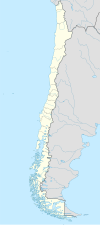|
Chonchi
Chonchi is a Chilean town and commune located in Los Lagos Region. The commune consists of the town of Chonchi and the following villages:
DemographicsAccording to the 2002 census of the National Statistics Institute, Chonchi spans an area of 1,362.1 km2 (526 sq mi) and has 12,572 inhabitants (6,453 men and 6,119 women). Of these, 4,588 (36.5%) lived in urban areas and 7,984 (63.5%) in rural areas. The population grew by 18.3% (1,945 persons) between the 1992 and 2002 censuses.[2] History     Originally Chonchi was a Jesuit mission station with a school which had 150 pupils in 1755, and the town itself was founded in 1767 by order of Don Guil y Gonzaga, the Governor of Chiloé.[3] In 1787 Chonchi had 315 inhabitants. Unification with Chile increased the economic importance of the region and promoted population growth. The 1833 census in Chonchi demonstrated that it was the most important town in south of the island. It became a parish in 1836, resuming its traditional religious significance within the area. A good anchorage made Chonchi a natural stopping place for traffic in the canals and timber exploitation transformed it into a hub for development of the region. The economic activity centred upon Chonchi reached its zenith at the beginning of the 20th century creating an opulent society with an active social circle. The influence of external ideas (Europeans) is clearly apparent in the town.[4] The pirate Pedro Ñancúpel was a native of Chonchi, being born in Terao 1837.[5] Architecture and SightsThe nickname of Chonchi is Ciudad de los Tres Pisos which means "Town of three floors". The ground floor corresponds to the harbour and the marine drive with the picturesque market Feria Artesanal, the second floor consists of the urban architecture around the museum, and the third floor is the main square with the church.[6]
Nearby AttractionsNearby attractions include Chiloé National Park and several lakes: Huillinco, Tarahuín, Natri and Tepuhueico. Huillinco, on Lago Huillinco, is a village of 943 inhabitants (2002), most of whom are Huilliche with an interesting cemetery.[8] Cucao is one of the very few settlements on Chiloé on the west coast. It is a village with 424 inhabitants (2000) at the entrance of Chiloé National Park.[9] AdministrationAs a commune, Chonchi is a third-level administrative division of Chile administered by a municipal council, headed by an alcalde who is directly elected every four years. The 2008-2012 alcalde is Pedro Andrade Oyarzún (PDC).[1] Within the electoral divisions of Chile, Chonchi is represented in the Chamber of Deputies by Gabriel Ascencio (PDC) and Alejandro Santana (RN) as part of the 58th electoral district, together with Castro, Ancud, Quemchi, Dalcahue, Curaco de Vélez, Quinchao, Puqueldón, Queilén, Quellón, Chaitén, Hualaihué, Futaleufú and Palena. The commune is represented in the Senate by Camilo Escalona Medina (PS) and Carlos Kuschel Silva (RN) as part of the 17th senatorial constituency (Los Lagos Region).       References
External linksWikimedia Commons has media related to Chonchi.
|
||||||||||||||||||||||||||||||||||||||||||||||||


